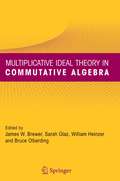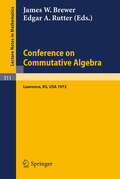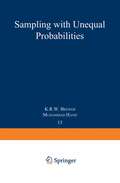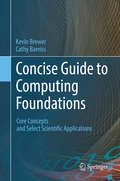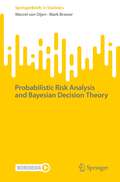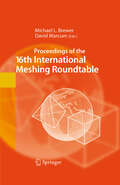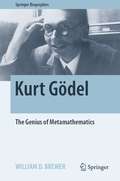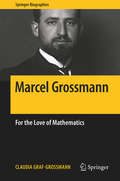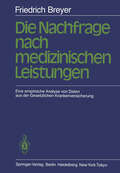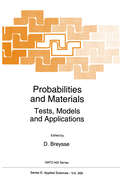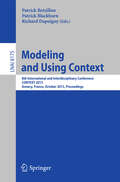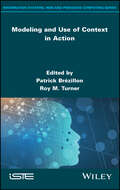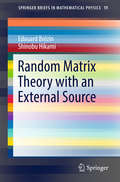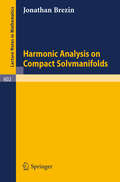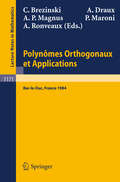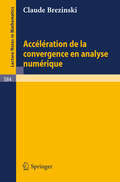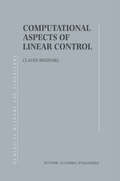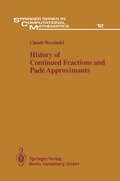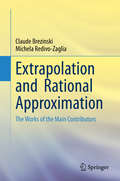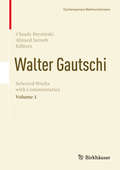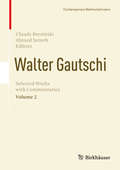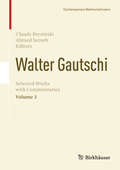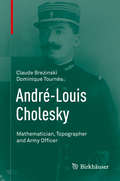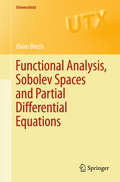- Table View
- List View
Multiplicative Ideal Theory in Commutative Algebra: A Tribute to the Work of Robert Gilmer
by James W. Brewer Sarah Glaz William Heinzer Bruce OlberdingThis volume, a tribute to the work of Robert Gilmer, consists of twenty-four articles authored by his most prominent students and followers. These articles combine surveys of past work by Gilmer and others, recent results which have never before seen print, open problems, and extensive bibliographies. The entire collection provides an in-depth overview of the topics of research in a significant and large area of commutative algebra.
Conference on Commutative Algebra: Lawrence, Kansas 1972 (Lecture Notes in Mathematics #311)
by James W. Brewer Edgar A. RutterProceedings
Concise Guide to Computing Foundations: Core Concepts and Select Scientific Applications
by Kevin Brewer Cathy BareissThis book will help future scientists to become more intelligent users of computing technology in their practice of science. The content is suitable for introductory courses on the foundations of computing and the specific application of computers in different areas of science. The text presents a set of modules for use in existing science courses in order to integrate individual aspects of computational thinking, as well as a set of modules introducing the computer science concepts needed to understand the computing involved. These modules guide science students in their independent learning. The book covers computing applications in such diverse areas as bioinformatics, chemical kinetics, hydrogeological modeling, and mechanics of materials, geographic information systems, flow analysis, the solving of equations, curve fitting, optimization, and scientific data acquisition. The computing topics covered include simulations, errors, data representation, algorithms, XMS, compression, databases, performance, and complexity.
Probabilistic Risk Analysis and Bayesian Decision Theory (SpringerBriefs in Statistics)
by Mark Brewer Marcel van OijenThe book shows how risk, defined as the statistical expectation of loss, can be formally decomposed as the product of two terms: hazard probability and system vulnerability. This requires a specific definition of vulnerability that replaces the many fuzzy definitions abounding in the literature. The approach is expanded to more complex risk analysis with three components rather than two, and with various definitions of hazard. Equations are derived to quantify the uncertainty of each risk component and show how the approach relates to Bayesian decision theory. Intended for statisticians, environmental scientists and risk analysts interested in the theory and application of risk analysis, this book provides precise definitions, new theory, and many examples with full computer code. The approach is based on straightforward use of probability theory which brings rigour and clarity. Only a moderate knowledge and understanding of probability theory is expected from the reader.
Proceedings of the 16th International Meshing Roundtable
by Michael L. Brewer David MarcumThis volume contains the articles presented at the 16th International Meshing Roundtable (IMR) organized, in part, by Sandia National Laboratories and held in Seattle, Washington, U.S.A. in October, 2007. The volume presents recent results of mesh generation and adaptation which has applications to finite element simulation. It introduces theoretical and novel ideas with practical potential.
Kurt Gödel: The Genius of Metamathematics (Springer Biographies)
by William D. BrewerDuring his lifetime, Kurt Gödel was not well known outside the professional world of mathematicians, philosophers and theoretical physicists. Early in his career, for his doctoral thesis and then for his Habilitation (Dr.Sci.), he wrote earthshaking articles on the completeness and provability of mathematical-logical systems, upsetting the hypotheses of the most famous mathematicians/philosophers of the time. He later delved into theoretical physics, finding a unique solution to Einstein’s equations for gravity, the ‘Gödel Universe’, and made contributions to philosophy, the guiding theme of his life. This book includes more details about the context of Gödel’s life than are found in earlier biographies, while avoiding an elaborate treatment of his mathematical/scientific/philosophical works, which have been described in great detail in other books. In this way, it makes him and his times more accessible to general readers, and will allow them to appreciate the lasting effects of Gödel’s contributions (the latter in a more up-to-date context than in previous biographies, many of which were written 15–25 years ago). His work spans or is relevant to a wide spectrum of intellectual endeavor, and this is emphasized in the book, with recent examples. This biography also examines possible sources of his unusual personality, which combined mathematical genius with an almost childlike naiveté concerning everyday life, and striking scientific innovations with timidity and hesitancy in practical matters. How he nevertheless had a long and successful career, inspiring many younger scholars along the way, with the help of his loyal wife Adele and some of his friends, is a fascinating story in human nature.
Marcel Grossmann: For the Love of Mathematics (Springer Biographies)
by William D. Brewer Claudia Graf-GrossmannZurich, summer 1912. Albert Einstein has just returned from Prague to the city on the Limmat. He sends a plea for help to his former fellow student, the mathematician Marcel Grossmann (1878-1936), for he is in need of assistance with the mathematical calculations of his general theory of relativity. What then follows is one of the most fascinating chapters of science history, with far-reaching consequences for the lives of the two friends. Marcel Grossmann’s granddaughter paints here a picture of a fiery and many-talented scientist and patriot. She traces the influence of an entrepreneurial family during Germany’s rapid industrial expansion in the late 19th century. The family’s fluctuating fortunes take the story to the vibrant city of Budapest on the Danube; they enable readers to sense the pioneering spirit at Zurich’s young Polytechnic Institute (now ETH Zurich) – but also reflect the worries and hardships of the First World War and interwar years. The Foreword is written by Prof. Remo Ruffini, founder and president of the International Center for Relativistic Astrophysics and the Marcel Grossmann Meetings. Last but not least, an extensive contribution by Dr. Tilman Sauer offers a scientific-historical appreciation of Marcel Grossmann’s enduring contributions.
Die Nachfrage nach medizinischen Leistungen: Eine empirische Analyse von Daten aus der Gesetzlichen Krankenversicherung
by F. BreyerProbabilities and Materials: Tests, Models and Applications (NATO Science Series E: #269)
by D. BreysseMost industrial and natural materials exhibit a macroscopic behaviour which results from the existence of microscale inhomogeneities. The influence of such inhomogeneities is commonly modelled using probabilistic methods. Most of the approaches to the evaluation of the safety of structures according to probabilistic criteria are somewhat scattered, however, and it is time to present such material in a coherent and up-to-date form. Probabilities and Materials undertakes this task, and also defines the great tasks that must be tackled in coming years. For engineers and researchers dealing with materials, geotechnics, solid mechanics, soil mechanics, statistics and stochastic processes. The expository nature of the book means that no prior knowledge of statistics or probability is required of the reader. The book can thus serve as an excellent introduction to the nature of applied statistics and stochastic modelling.
Modeling and Using Context: 8th International and Interdisciplinary Conference, CONTEXT 2013, Annecy, France, October 28 - 31, 2013, Proceedings (Lecture Notes in Computer Science #8175)
by Patrick Brézillon Patrick Blackburn Richard DapoignyThis book constitutes the proceedings of the 8th International and Interdisciplinary Conference on Modeling and Using Context, CONTEXT 2013, held in Annecy, France, in October/November 2013. The 23 full papers and 9 short papers presented were carefully reviewed and selected from numerous submissions. In addition the book contains two keynote speeches and 9 poster papers. They cover cutting-edge results from the wide range of disciplines concerned with context, including: Cognitive Sciences (Linguistics, Psychology, Computer Science, Neuroscience), and computer science (artificial intelligence, logics, ubiquitous and pervasive computing, context-awareness systems), and the Social Sciences and Organizational Sciences, as well as the Humanities and all application areas, including Medicine and Law.
Modeling and Use of Context in Action
by Patrick Brézillon Roy M. TurnerThis book brings together current research and adopts a pragmatic approach to modeling and using context to solve real-world problems. The editors were instrumental in creating - and continue to be involved in - the interdisciplinary research community, centered around the biennial CONTEXT (International and Interdisciplinary Conference on Modeling and Using Context) conference series, focused on studying context and its implications for artificial intelligence, software applications, psychology, philosophy, linguistics, neuroscience, as well as other fields.The first three chapters lay the foundations, looking at the lessons learned over the past 25 years and arguing for a continued shift toward more pragmatic approaches. The remaining chapters contain contributions to pragmatic context-based research from a wide range of domains, including technological problems - such as subway incident management and autonomous underwater vehicle control - identifying emotions from speech without understanding the words, anonymization in a world where privacy is increasingly threatened, teaching in context and improving management teaching in a business school.
Modeling and Use of Context in Action
by Patrick Brézillon Roy M. TurnerThis book brings together current research and adopts a pragmatic approach to modeling and using context to solve real-world problems. The editors were instrumental in creating - and continue to be involved in - the interdisciplinary research community, centered around the biennial CONTEXT (International and Interdisciplinary Conference on Modeling and Using Context) conference series, focused on studying context and its implications for artificial intelligence, software applications, psychology, philosophy, linguistics, neuroscience, as well as other fields.The first three chapters lay the foundations, looking at the lessons learned over the past 25 years and arguing for a continued shift toward more pragmatic approaches. The remaining chapters contain contributions to pragmatic context-based research from a wide range of domains, including technological problems - such as subway incident management and autonomous underwater vehicle control - identifying emotions from speech without understanding the words, anonymization in a world where privacy is increasingly threatened, teaching in context and improving management teaching in a business school.
Random Matrix Theory with an External Source (SpringerBriefs in Mathematical Physics #19)
by Edouard Brézin Shinobu HikamiThis is a first book to show that the theory of the Gaussian random matrix is essential to understand the universal correlations with random fluctuations and to demonstrate that it is useful to evaluate topological universal quantities. We consider Gaussian random matrix models in the presence of a deterministic matrix source. In such models the correlation functions are known exactly for an arbitrary source and for any size of the matrices. The freedom given by the external source allows for various tunings to different classes of universality. The main interest is to use this freedom to compute various topological invariants for surfaces such as the intersection numbers for curves drawn on a surface of given genus with marked points, Euler characteristics, and the Gromov–Witten invariants. A remarkable duality for the average of characteristic polynomials is essential for obtaining such topological invariants. The analysis is extended to nonorientable surfaces and to surfaces with boundaries.
Polynomes Orthogonaux et Applications: Proceedings of the Laguerre Symposium held at Bar-le-Duc, October 15-18, 1984 (Lecture Notes in Mathematics #1171)
by C. Brezinski A. Draux A. P. Magnus P. Maroni A. RonveauxAcceleration de la convergence en analyse numerique (Lecture Notes in Mathematics #584)
by Claude BrezinskiComputational Aspects of Linear Control (Numerical Methods and Algorithms #1)
by Claude BrezinskiMany devices (we say dynamical systems or simply systems) behave like black boxes: they receive an input, this input is transformed following some laws (usually a differential equation) and an output is observed. The problem is to regulate the input in order to control the output, that is for obtaining a desired output. Such a mechanism, where the input is modified according to the output measured, is called feedback. The study and design of such automatic processes is called control theory. As we will see, the term system embraces any device and control theory has a wide variety of applications in the real world. Control theory is an interdisci plinary domain at the junction of differential and difference equations, system theory and statistics. Moreover, the solution of a control problem involves many topics of numerical analysis and leads to many interesting computational problems: linear algebra (QR, SVD, projections, Schur complement, structured matrices, localization of eigenvalues, computation of the rank, Jordan normal form, Sylvester and other equations, systems of linear equations, regulariza tion, etc), root localization for polynomials, inversion of the Laplace transform, computation of the matrix exponential, approximation theory (orthogonal poly nomials, Pad6 approximation, continued fractions and linear fractional transfor mations), optimization, least squares, dynamic programming, etc. So, control theory is also a. good excuse for presenting various (sometimes unrelated) issues of numerical analysis and the procedures for their solution. This book is not a book on control.
History of Continued Fractions and Padé Approximants (Springer Series in Computational Mathematics #12)
by Claude BrezinskiThe history of continued fractions is certainly one of the longest among those of mathematical concepts, since it begins with Euclid's algorithm for the great est common divisor at least three centuries B.C. As it is often the case and like Monsieur Jourdain in Moliere's "Ie bourgeois gentilhomme" (who was speak ing in prose though he did not know he was doing so), continued fractions were used for many centuries before their real discovery. The history of continued fractions and Pade approximants is also quite im portant, since they played a leading role in the development of some branches of mathematics. For example, they were the basis for the proof of the tran scendence of 11' in 1882, an open problem for more than two thousand years, and also for our modern spectral theory of operators. Actually they still are of great interest in many fields of pure and applied mathematics and in numerical analysis, where they provide computer approximations to special functions and are connected to some convergence acceleration methods. Con tinued fractions are also used in number theory, computer science, automata, electronics, etc ...
Extrapolation and Rational Approximation: The Works of the Main Contributors
by Claude Brezinski Michela Redivo-ZagliaThis book paints a fresco of the field of extrapolation and rational approximation over the last several centuries to the present through the works of their primary contributors. It can serve as an introduction to the topics covered, including extrapolation methods, Padé approximation, orthogonal polynomials, continued fractions, Lanczos-type methods etc.; it also provides in depth discussion of the many links between these subjects.A highlight of this book is the presentation of the human side of the fields discussed via personal testimonies from contemporary researchers, their anecdotes, and their exclusive remembrances of some of the “actors.” This book shows how research in this domain started and evolved. Biographies of other scholars encountered have also been included. An important branch of mathematics is described in its historical context, opening the way to new developments. After a mathematical introduction, the book contains a precise description of the mathematical landscape of these fields spanning from the 19th century to the first part of the 20th. After an analysis of the works produced after that period (in particular those of Richardson, Aitken, Shanks, Wynn, and others), the most recent developments and applications are reviewed.
Walter Gautschi, Volume 1: Selected Works with Commentaries (Contemporary Mathematicians)
by Claude Brezinski Ahmed SamehWalter Gautschi has written extensively on topics ranging from special functions, quadrature and orthogonal polynomials to difference and differential equations, software implementations, and the history of mathematics. He is world renowned for his pioneering work in numerical analysis and constructive orthogonal polynomials, including a definitive textbook in the former, and a monograph in the latter area. This three-volume set, Walter Gautschi: Selected Works with Commentaries, is a compilation of Gautschi’s most influential papers and includes commentaries by leading experts. The work begins with a detailed biographical section and ends with a section commemorating Walter’s prematurely deceased twin brother. This title will appeal to graduate students and researchers in numerical analysis, as well as to historians of science. Selected Works with Commentaries, Vol. 1Numerical ConditioningSpecial FunctionsInterpolation and Approximation Selected Works with Commentaries, Vol. 2Orthogonal Polynomials on the Real LineOrthogonal Polynomials on the SemicircleChebyshev QuadratureKronrod and Other QuadraturesGauss-type Quadrature Selected Works with Commentaries, Vol. 3Linear Difference EquationsOrdinary Differential EquationsSoftwareHistory and BiographyMiscellaneaWorks of Werner Gautschi
Walter Gautschi, Volume 2: Selected Works with Commentaries (Contemporary Mathematicians)
by Claude Brezinski Ahmed SamehWalter Gautschi has written extensively on topics ranging from special functions, quadrature and orthogonal polynomials to difference and differential equations, software implementations, and the history of mathematics. He is world renowned for his pioneering work in numerical analysis and constructive orthogonal polynomials, including a definitive textbook in the former, and a monograph in the latter area. This three-volume set, Walter Gautschi: Selected Works with Commentaries, is a compilation of Gautschi’s most influential papers and includes commentaries by leading experts. The work begins with a detailed biographical section and ends with a section commemorating Walter’s prematurely deceased twin brother. This title will appeal to graduate students and researchers in numerical analysis, as well as to historians of science. Selected Works with Commentaries, Vol. 1Numerical ConditioningSpecial FunctionsInterpolation and Approximation Selected Works with Commentaries, Vol. 2Orthogonal Polynomials on the Real LineOrthogonal Polynomials on the SemicircleChebyshev QuadratureKronrod and Other QuadraturesGauss-type Quadrature Selected Works with Commentaries, Vol. 3Linear Difference EquationsOrdinary Differential EquationsSoftwareHistory and BiographyMiscellaneaWorks of Werner Gautschi
Walter Gautschi, Volume 3: Selected Works with Commentaries (Contemporary Mathematicians)
by Claude Brezinski Ahmed SamehWalter Gautschi has written extensively on topics ranging from special functions, quadrature and orthogonal polynomials to difference and differential equations, software implementations, and the history of mathematics. He is world renowned for his pioneering work in numerical analysis and constructive orthogonal polynomials, including a definitive textbook in the former, and a monograph in the latter area. This three-volume set, Walter Gautschi: Selected Works with Commentaries, is a compilation of Gautschi’s most influential papers and includes commentaries by leading experts. The work begins with a detailed biographical section and ends with a section commemorating Walter’s prematurely deceased twin brother. This title will appeal to graduate students and researchers in numerical analysis, as well as to historians of science. Selected Works with Commentaries, Vol. 1Numerical ConditioningSpecial FunctionsInterpolation and Approximation Selected Works with Commentaries, Vol. 2Orthogonal Polynomials on the Real LineOrthogonal Polynomials on the SemicircleChebyshev QuadratureKronrod and Other QuadraturesGauss-type Quadrature Selected Works with Commentaries, Vol. 3Linear Difference EquationsOrdinary Differential EquationsSoftwareHistory and BiographyMiscellaneaWorks of Werner Gautschi
André-Louis Cholesky: Mathematician, Topographer and Army Officer
by Claude Brezinski Dominique TournèsThis book traces the life of Cholesky (1875-1918), and gives his family history. After an introduction to topography, an English translation of an unpublished paper by him where he explained his method for linear systems is given, studied and replaced in its historical context. His other works, including two books, are also described as well as his involvement in teaching at a superior school by correspondence. The story of this school and its founder, Léon Eyrolles, are addressed. Then, an important unpublished book of Cholesky on graphical calculation is analyzed in detail and compared to similar contemporary publications. The biography of Ernest Benoit, who wrote the first paper where Cholesky´s method is explained, is provided. Various documents, highlighting the life and the personality of Cholesky, end the book.
Functional Analysis, Sobolev Spaces and Partial Differential Equations (Universitext)
by Haim BrezisThis textbook is a completely revised, updated, and expanded English edition of the important Analyse fonctionnelle (1983). In addition, it contains a wealth of problems and exercises (with solutions) to guide the reader. Uniquely, this book presents in a coherent, concise and unified way the main results from functional analysis together with the main results from the theory of partial differential equations (PDEs). Although there are many books on functional analysis and many on PDEs, this is the first to cover both of these closely connected topics. Since the French book was first published, it has been translated into Spanish, Italian, Japanese, Korean, Romanian, Greek and Chinese. The English edition makes a welcome addition to this list.
